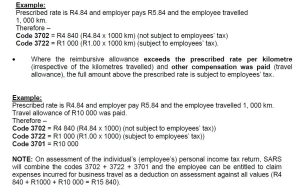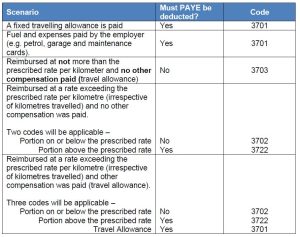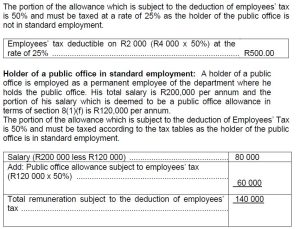Purpose
The purpose of this Webpage is to assist employers in understanding their obligations relating to allowances paid or payable to their employees.
Scope
This basic guide explains the methods to be applied by the employers in respect of allowances paid or payable to employees and includes the legislation requirements as well as examples.
Allowances
Subsistence Allowance
| Reference to the Act | Section 8(1)(a) read together with section 8(1)(c) of the Income Tax Act No. 58 of 1962 (the Income Tax Act). |
| Meaning | A subsistence allowance is any allowance given to an employee or a holder of any office for expenses incurred or to be incurred in respect of personal subsistence and incidental costs (for example, drinks, lunch, parking). |
| Amounts deemed to be expended | Section 8(1)(c) of the Income Tax Act prescribes that the employee shall be deemed to have actually expended a certain amount (daily expenses in respect of meals and/or incidentals costs) where the employee is absent from his/her usual place of residence. Where the accommodation to which the allowance or advance relates is in the Republic, an amount equal to the following is deemed to be expended for each day or part of a day in the period during which the employee is absent from his/her usual place of residence —
Section 8(1)(a)(ii) of the Income Tax Act states that where the recipient is by reason of the duties of his or her office or employment obliged to spend a part of a day away from his or her usual place of work or employment and provides proof of such expenditure to the employer, a reimbursement or advance for such expenditure actually incurred by the recipient is excluded from taxable income if the recipient is allowed by his or her principal to incur expenditure on meals and other incidental costs for that part of a day and the amount of the expenditure does not exceed an amount of R169. |
| Example | If an employer allows an employee to incur expenditure on meals when obliged to spend a part of a day away from his/her usual place of work/employment by reason of the employee’s employment, and reimburses the employee upon the submission of proof of expenditure, such reimbursement up to an amount announced by notice in the Gazette (R169 per day for the 2025 YoA), is not taxable and must therefore not be declared on the IRP5/IT3(a). However, where the reimbursement exceeds the lower of the amount announced or the amount for which proof of expenditure was submitted by the employee, the excess is fully taxable and therefore liable to PAYE and must be declared under income code 3713 on the IRP5/IT3(a). |
| Employer borne expenses | Where the accommodation to which the allowance or advance relates is outside the Republic, an amount equal to prescribed amount applicable to the relevant country is deemed to be expended for each day or part of a day in the period during which the employee is absent from his/her usual place of residence in accordance with the table for the country in which that accommodation is located, please refer to Subsistence Allowance – Foreign travel – external annexure. |
| Please note | The rates are for guidance purposes only. The rates for each tax year will be published by notice in the Government Gazette The amounts laid down in respect of travelling abroad will only apply to employees who are ordinarily resident in the Republic in respect of continuous periods spent outside the Republic. The amounts that shall be deemed to be expended do not apply to the extent that the employer has borne the expenses (otherwise than by way of payment or granting of an allowance or advance) in respect of which the allowance was paid for each day or part of a day. A subsistence allowance is intended for abnormal circumstances and therefore an allowance of this nature cannot form part of the remuneration package of an employee. It is an amount paid by an employer to the employee IN ADDITION to the employee’s normal remuneration. For more information in this regard, please refer to Interpretation Note No.14 on the SARS website, www.sars.gov.za under Interpretation Notes/Income Tax. If a subsistence allowance or advance is paid to an employee on or after 1 February 2006, the allowance or advance is deemed to become payable to the employee in the following month in respect of services rendered where such an allowance or advance was paid to the employee during any month in respect of a night away from his/her usual place of residence and that employee has not by the last day of the following month either spent the night away or refunded that amount to the employer. |
| Employees’ tax | Employees’ tax must not be deducted from the subsistence allowance, regardless of whether the deemed amounts and/or prescribed periods are exceeded. |
Travel Allowance
| Reference to the Act | Section 8(1)(b) |
| Meaning | A travel allowance is any allowance paid or advance given to an employee in respect of travelling expenses for business purposes. Any allowance or advance in respect of travelling expenses not to have been expended on business travelling to the extent that it has been spent on private travelling (this includes travelling between the employee’s place of residence and his/her place of employment or any other travelling done for his or her private or domestic purposes), shall be deemed not to have been actually expended on travelling for business. The following two situations are envisaged, namely —
The definition of variable remuneration was extended to include any amount paid or granted in reimbursement of any expenditure. Therefore, any allowance or advance paid as variable remuneration in terms of section 7B must be included in the tax year that the allowance or advance is paid to the employee and NOT when it was incurred. |
| Travel allowance | The employees’ tax deducted in respect of the travel allowance must be reflected as Pay-As-You-Earn (PAYE). The total travel allowance (100%) must be reflected on the IRP5 certificate under code 3701. 80% of the travel allowance paid to an employee is subject to the deduction of employees’ tax. Where the employer is satisfied that at least 80% of the use of the motor vehicle for a year of assessment will be for business purposes, then only 20% of the allowance is subject to the deduction of employees’ tax effective from 1 March 2011. Note that this determination must be done on a monthly basis. If an employer withheld employees’ tax on only 20% of an employee’s travel allowance and circumstances change such that the employer realizes that the employee will no longer use the vehicle at least 80% for business purposes during the year of assessment, from the month in which the circumstances change, employees’ tax must be withheld on the 80% of employee’s travel allowance. Where a travel allowance is paid in addition to a reimbursive allowance (see discussion below) or vice versa, both the amounts will be combined on assessment by SARS. These combined allowances will be treated as a taxable travel allowance. The employee should claim a travel deduction on his/her personal income tax return. |
| Vehicle let to the employer | Where an employee, his/her spouse or child owns or leases a motor vehicle (whether directly or indirectly by virtue of an interest in a company, trust or otherwise) and such vehicle is let to the employer or associated institution in relation to the employer, the sum of the rental paid by the employer together with any expenditure in respect of the vehicle which was borne by the employer, is deemed to be a travel allowance. This deemed travel allowance must be declared as such and the employee will be entitled to claim expenses incurred for business travel as a deduction on assessment. Note: The rental received by the employee must not be declared as rental income but as a travel allowance. Although the employee obtains the right of use of the vehicle from his/her employer, he/she is not subject to tax on the benefit arising from the private use of such motor vehicle. |
| Reimbursive travel allowance | A reimbursive travel allowance is where an allowance or advance is based on the actual distance travelled for business purposes (that is excluding private use). |
| Prescribed rate per kilometre | The rate per kilometre is fixed by the Minister of Finance and currently is —
Pre 1 March 2018 (2018 and prior tax years) – An allowance or advance which is based on the actual distance travelled for business purposes (reimbursive travel) is not subject to employees’ tax but the full amount must be reflected on the IRP5 certificate —
The table hereunder displays the relevant source codes under which the amounts must be reflected on the IRP5/IT3(a) certificate for 2018 and prior the tax years.
From 1 March 2018 –
The table hereunder displays the relevant source codes under which the amounts must be reflected on the IRP5/IT3(a) certificate from 1 March 2018.
|
Allowance to a Holder of a Public Office
| Reference to the Act | Section 8(1)(d) and 8(1)(f) |
| Meaning | Any allowance granted to the holder of a public office to enable him/her to defray expenditure incurred by him/her in connection with his/her office, to have been expended by him/her to the extent that he/she has actually incurred expenses for the purposes of his/her office in respect of —
Where it is expected from the following office holders:
|
| Portion of salary deemed to be a public office allowance | To defray any expenditure out of his/her salary, an amount equal to a portion of such salary is deemed to be an allowance to the holder of a public office. This is prescribed by the provisions in section 8(1) (f) and the amount is determined by the National Assembly or the President. Where the employee has held a public office for less than 12 months, the portion of his/her salary which is deemed to be an allowance to a holder of a public office in terms of section 8(1)(f), must be apportioned to determine the amount relevant for the actual period for which the office was held. A part of a month shall be reckoned as a full month. |
| Employees’ tax | Only a 50% portion of the allowance is subject to the deduction of employees’ tax. |
| IRP5/IT3(a) details | The full allowance (100%) must be reflected under code 3708; and All the other income components must be reflected under the relevant codes (e.g. salary, overtime, bonus, etc.). |
| Example | Holder of a public office not in standard employment: A holder of a public office receives an allowance of R4 000 per month to enable him to defray expenditure in respect of his office. The portion of the allowance which is subject to the deduction of employees’ tax is 50% and must be taxed at a rate of 25% as the holder of the public office is not in standard employment.
|
Definitions, acronyms and abbreviations
The definitions, acronyms and abbreviations can be accessed via the following link: Glossary webpage.
Legal disclaimer: In the event of conflict or inconsistency between this webpage and the PDF version of the guide, the latter shall prevail.
.




